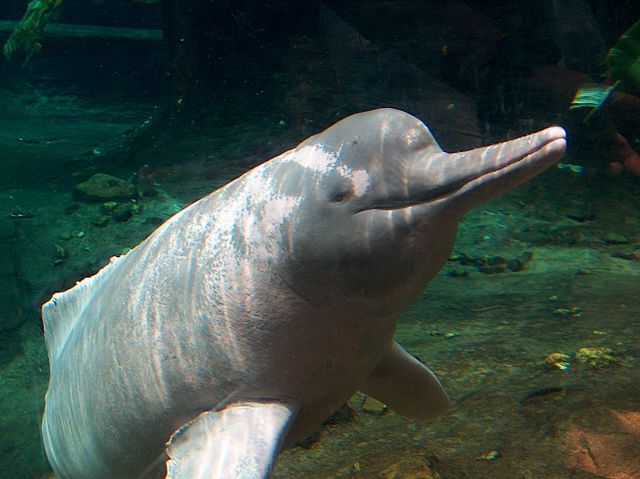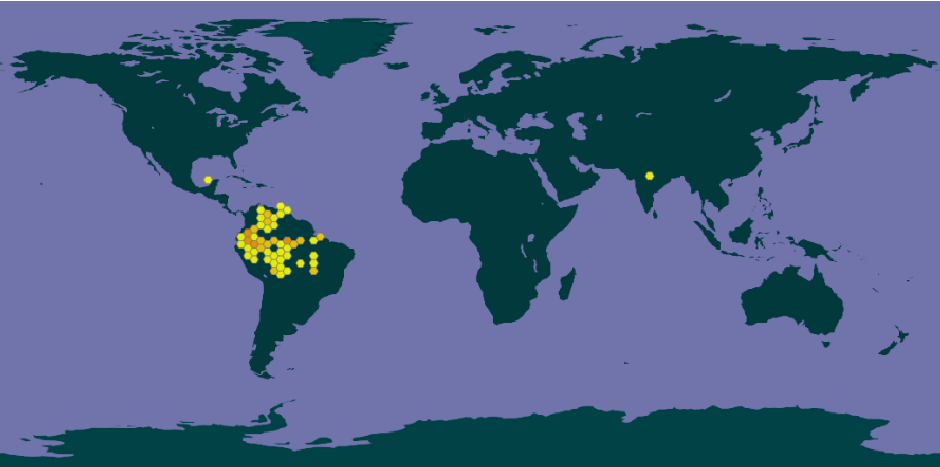Inia geoffrensis (Blainville, 1817)
Amazon river dolphin

| Kingdom | Animalia |
| Phylum | Chordata |
| Class | Mammalia |
| Order | Artiodactyla |
| Family | Iniidae |
| Genus | Inia |
| Species | Inia geoffrensis (Blainville, 1817) |
Listen to the SONIFIED SPECIES

Known records of this species

Taxon Description
The Amazon river dolphin (Inia geoffrensis), also known as the boto, bufeo or pink river dolphin, is a species of toothed whale endemic to South America and is classified in the family Iniidae. Three subspecies are currently recognized: I. g. geoffrensis (Amazon river dolphin), I. g. boliviensis (Bolivian river dolphin) and I. g. humboldtiana (Orinoco river dolphin) while position of Araguaian river dolphin (I. araguaiaensis) within the clade is still unclear. The three subspecies are distributed in the Amazon basin, the upper Madeira River in Bolivia, and the Orinoco basin, respectively. The Amazon river dolphin is the largest species of river dolphin, with adult males reaching 185 kilograms (408 lb) in weight, and 2.5 metres (8.2 ft) in length. Adults acquire a pink color, more prominent in males, giving it its nickname “pink river dolphin”. Sexual dimorphism is very evident, with males measuring 16% longer and weighing 55% more than females. Like other toothed whales, they have a melon, an organ that is used for bio sonar. The dorsal fin, although short in height, is regarded as long, and the pectoral fins are also large. The fin size, unfused vertebrae, and its relative size allow for improved manoeuvrability when navigating flooded forests and capturing prey.
Taxonomy
The species Inia geoffrensis was described by Henri Marie Ducrotay de Blainville in 1817. Originally, the Amazon river dolphin belonged to the superfamily Platanistoidea, which constituted all river dolphins, making them a paraphyletic group. Today, however, the Amazon river dolphin has been reclassified into the superfamily Inioidea. There is no consensus on when and how their ancestral species penetrated the Amazon basin; they may have done so during the Miocene from the Pacific Ocean, before the formation of the Andes, or from the Atlantic Ocean. There is ongoing debate about the classification of species and subspecies. The IUCN and Committee on Taxonomy of the Society for Marine Mammalogy recognize two subspecies: I. g. geoffrensis (Amazon river dolphin) and I. g. boliviensis (Bolivian river dolphin). A third proposed subspecies, I. g. humboldtiana (Orinoco river dolphin), was first described in 1977. Molecular analysis suggests that the Orinoco dolphins are derived from the Amazon population and are not genetically distinct. Comparative morphological research also indicates that I. g. humboldtiana is not distinguishable from I. g. geoffrensis. However, Cañizales (2020) found that I. g. humboldtiana skulls were morphologically distinct and recommended that it be elevated to species status.